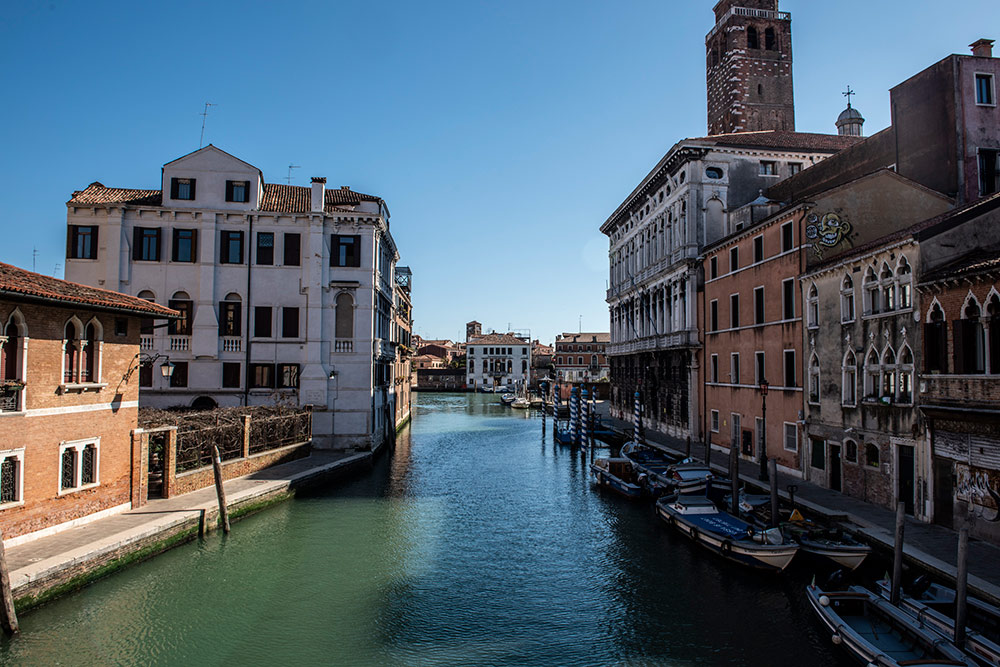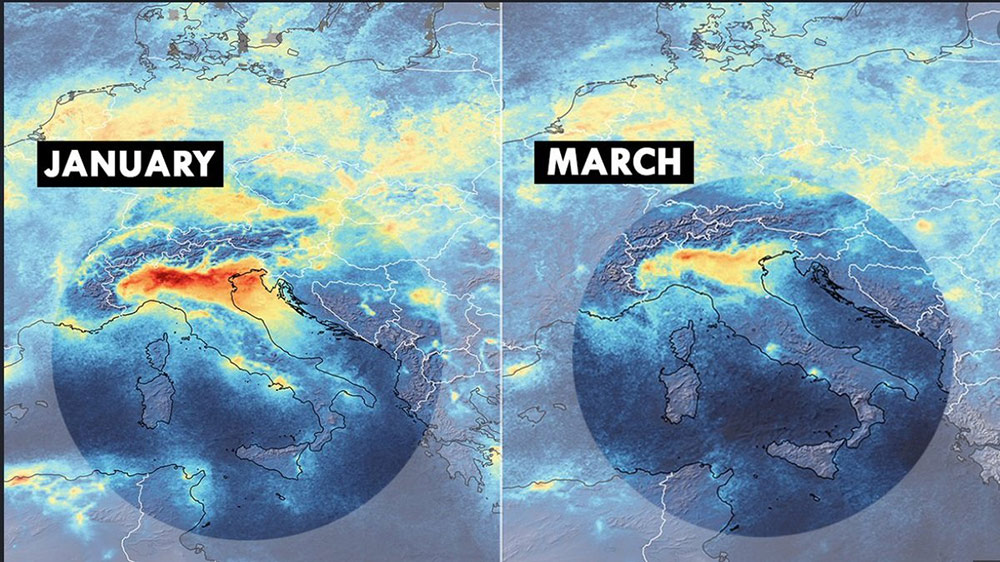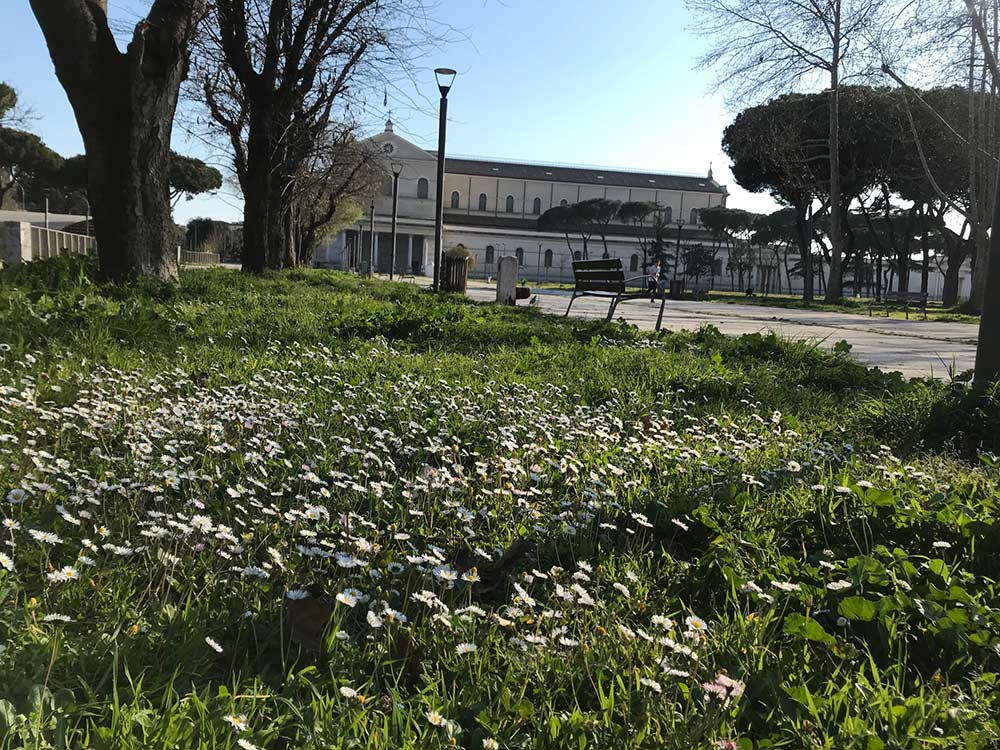疫情让意大利生态环境变好,只是代价太沉重

意大利经济大规模停摆仅持续了数周,当地生态环境似乎迅速好转——当然,代价也十分惨重。
此次新冠肺炎疫情对意大利造成了毁灭性的影响,一个个数字的背后都是鲜活的生命。截至当地时间上周日,意大利卫生部累计报告病例接近6万例,死亡人数5400余例,超过中国,成为通报新冠死亡病例人数最多的国家。
意大利总理朱塞佩·孔特已下令关闭学校、餐厅、酒吧、旅游景点、办公楼、电影院等易发生人群聚集的场所。类似举措也已在欧洲多国推行,意大利经济因此遭受重创,预计今年经济萎缩可能高达15%。而生性热情的意大利人被告知要保持社交距离,当地社交规范也发生了变化。
但是环境呢?环境的表现倒还不错。
欧洲航天局今年1月和3月拍摄的卫星图像显示,意大利北部经济重镇在大幅减少交通流量和工业活动后,生态环境发生了显著变化。

1月份意大利封锁之前的污染水平,对比3月份全面封锁后的水平。这也反映了意大利经济最发达的是北部地区,以及图中两个小点所代表的罗马和那不勒斯。图片来自@ESA。#意大利新冠肺炎 #污染
意大利素有“美丽国度”之称,不过当地空气质量堪忧,特别是在工业发达的波河河谷地区,新冠肺炎疫情尤其严重。近年来,由于雾霾指数超标,当局采取了机动车限行措施,在部分时段禁止柴油汽车出行。而如今,绝大多数居民都在家隔离,街道上的车流量大幅减少。
与此同时,水城威尼斯市内及周边的游轮和货船几乎全部停运,几十年来首次有鱼类回到了威尼斯的泻湖和运河中。
据意大利媒体报道,由于空气质量改善且游人稀少,罗马的公园里百花齐放,丛丛野花盛开,而往年只有到了5月才能看到如此规模的美景。

在首先爆发新冠疫情的中国湖北省,以及世界上其他连续封锁多日的地区也有类似的报道。据一份报告估计,中国过去一个月内的温室气体排放量比正常水平低了四分之一。
尽管分析人士可能会为这些数字而欢呼,但我们付出的代价过于沉重,即使从环境角度而言也是如此。
曾在2016年及之前担任联合国气候变化事务高级官员的克里斯蒂安娜·菲格雷斯在接受《财富》采访时表示:“我们在很短的时间内看到了积极进展,这在其他任何情况下都是我们乐于见到的。但我们不希望通过这种方式达到目标,这些改观充其量也只是一时的。”菲格雷斯最近还与人合著了一本新书,探讨应对气候变化的优先事项。
2008至2009年全球金融危机期间也发生了类似的情况。当时全世界温室气体排放量增长下降了一半,但在经济全面复苏后,排放量又迅速回升。
国际石油变革组织战略传播总监大卫·特恩布尔认为,要确保这些短期环境效益得以持续,决策者必须确保所有与新冠疫情有关的经济刺激计划都强调可持续发展。
特恩布尔表示:“新冠病毒当今世界面临的最大问题,但在疫情爆发之前,最大的问题是气候变化。而在疫情消退之后,气候变化依旧是重中之重。然而我们可以同时应对这两个挑战。各国政府应该表明它们可以兼顾两者,确保在为经济注入数万亿美元的同时,继续降低温室气体排放,以可持续的方式促进经济增长。”
在目前看来,情况似乎恰恰相反。据报道,本周四,欧盟委员会官员认为新冠大流行迫使他们“重新调整优先事项”,这意味着促进生物多样性战略和反食物浪费措施等关键的环境改革可能会被暂时搁置。
菲格雷斯认为,这样我们就错过了大好时机。她指出:“保护环境和抗击疫情都是当务之急,我们不应该有所取舍。”
意大利环保组织Legambiente研究部负责人安德烈亚·米努托洛认为,从严格的环境角度而言,意大利封锁全境很可能会带来“净积极”影响,但这也不是绝对的。
米努托洛告诉《财富》杂志说:“我们看到的一些情况是季节性的。虽然封锁使交通和工业活动有所减少,但居民居家隔离消耗的能源也增加了。唯一让大家统一方向、形成合力的办法是建立正确的规则和鼓励机制。我们应该通过这种办法走出危机。”(财富中文网)
译者:智竑
为了应对新冠疫情,意大利宣布紧急封锁全境,限制了6000万人的出行。如果说封锁禁令有什么积极意义的话,也许人们可以在日落时分或者观察水道时得到意外收获。
意大利经济大规模停摆仅持续了数周,当地生态环境似乎迅速好转——当然,代价也十分惨重。
此次新冠肺炎疫情对意大利造成了毁灭性的影响,一个个数字的背后都是鲜活的生命。截至当地时间上周日,意大利卫生部累计报告病例接近6万例,死亡人数5400余例,超过中国,成为通报新冠死亡病例人数最多的国家。
意大利总理朱塞佩·孔特已下令关闭学校、餐厅、酒吧、旅游景点、办公楼、电影院等易发生人群聚集的场所。类似举措也已在欧洲多国推行,意大利经济因此遭受重创,预计今年经济萎缩可能高达15%。而生性热情的意大利人被告知要保持社交距离,当地社交规范也发生了变化。
但是环境呢?环境的表现倒还不错。
欧洲航天局今年1月和3月拍摄的卫星图像显示,意大利北部经济重镇在大幅减少交通流量和工业活动后,生态环境发生了显著变化。
1月份意大利封锁之前的污染水平,对比3月份全面封锁后的水平。这也反映了意大利经济最发达的是北部地区,以及图中两个小点所代表的罗马和那不勒斯。图片来自@ESA。#意大利新冠肺炎 #污染
意大利素有“美丽国度”之称,不过当地空气质量堪忧,特别是在工业发达的波河河谷地区,新冠肺炎疫情尤其严重。近年来,由于雾霾指数超标,当局采取了机动车限行措施,在部分时段禁止柴油汽车出行。而如今,绝大多数居民都在家隔离,街道上的车流量大幅减少。
与此同时,水城威尼斯市内及周边的游轮和货船几乎全部停运,几十年来首次有鱼类回到了威尼斯的泻湖和运河中。
据意大利媒体报道,由于空气质量改善且游人稀少,罗马的公园里百花齐放,丛丛野花盛开,而往年只有到了5月才能看到如此规模的美景。
在首先爆发新冠疫情的中国湖北省,以及世界上其他连续封锁多日的地区也有类似的报道。据一份报告估计,中国过去一个月内的温室气体排放量比正常水平低了四分之一。
尽管分析人士可能会为这些数字而欢呼,但我们付出的代价过于沉重,即使从环境角度而言也是如此。
曾在2016年及之前担任联合国气候变化事务高级官员的克里斯蒂安娜·菲格雷斯在接受《财富》采访时表示:“我们在很短的时间内看到了积极进展,这在其他任何情况下都是我们乐于见到的。但我们不希望通过这种方式达到目标,这些改观充其量也只是一时的。”菲格雷斯最近还与人合著了一本新书,探讨应对气候变化的优先事项。
2008至2009年全球金融危机期间也发生了类似的情况。当时全世界温室气体排放量增长下降了一半,但在经济全面复苏后,排放量又迅速回升。
国际石油变革组织战略传播总监大卫·特恩布尔认为,要确保这些短期环境效益得以持续,决策者必须确保所有与新冠疫情有关的经济刺激计划都强调可持续发展。
特恩布尔表示:“新冠病毒当今世界面临的最大问题,但在疫情爆发之前,最大的问题是气候变化。而在疫情消退之后,气候变化依旧是重中之重。然而我们可以同时应对这两个挑战。各国政府应该表明它们可以兼顾两者,确保在为经济注入数万亿美元的同时,继续降低温室气体排放,以可持续的方式促进经济增长。”
在目前看来,情况似乎恰恰相反。据报道,本周四,欧盟委员会官员认为新冠大流行迫使他们“重新调整优先事项”,这意味着促进生物多样性战略和反食物浪费措施等关键的环境改革可能会被暂时搁置。
菲格雷斯认为,这样我们就错过了大好时机。她指出:“保护环境和抗击疫情都是当务之急,我们不应该有所取舍。”
意大利环保组织Legambiente研究部负责人安德烈亚·米努托洛认为,从严格的环境角度而言,意大利封锁全境很可能会带来“净积极”影响,但这也不是绝对的。
米努托洛告诉《财富》杂志说:“我们看到的一些情况是季节性的。虽然封锁使交通和工业活动有所减少,但居民居家隔离消耗的能源也增加了。唯一让大家统一方向、形成合力的办法是建立正确的规则和鼓励机制。我们应该通过这种办法走出危机。”(财富中文网)
译者:智竑
If there’s something positive to be found in Italy’s emergency coronavirus orders to lock down 60 million residents, it might reveal itself in a sunset or while peering down at the waterways.
After just a few weeks of shutting down huge portions of the economy, the country’s environmental health already appears to be making a roaring comeback—at a heavy cost, of course.
Measured in lives, the COVID-19 outbreak has had a devastating impact on the country. As of Wednesday’s report from Italian health officials, the outbreak had killed nearly 3,000 with total cases nearing 36,000. In both measures, only China has recorded more.
A decree from Prime Minister Giuseppe Conte shut down schools, restaurants, bars, tourist sites, offices, cinemas, or any other place where crowds may gather in close proximity. That measure, now being followed in part in other European countries, is ravaging Italy’s economy, which could contract by as much as 15% this year. Social norms have changed, too, as typically social Italians are told to stay far away from one another.
But the environment? It’s doing just fine.
The impact of a big reduction in vehicle traffic and industrial activity across the economically vibrant northern swath of the country is evident in European Space Agency satellite photos comparing January with March.
Pollution l evels in #Italy in January, before the #coronavirus lockdown, and in March, with the #lockdown in full force. This also illustrates how much of Italy's economy is in the north, plus two small blips for #Rome and #Naples. Images from @ESA. #coronavirusItaly #Pollution pic.twitter.com/3S51JW6YvT
— Eric J. Lyman (@EricJLyman) March 17, 2020
Also known as the bel paese, or “beautiful country,” Italy has a vexing air-quality problem, particularly in the industrial Po Valley region where the coronavirus outbreak is at its worst. In recent years, Italians have been ordered to leave their polluting, diesel-powered cars at home on various days as smog levels exceeded health standards. Car traffic these days is at a fraction of what it once was as people have been largely confined to their homes.
Meanwhile, a near shutdown of cruise- and cargo-ship traffic around Italy’s canal city of Venice has resulted in fish returning to the Venice lagoon and canals for the first time in decades.
Italian media credits cleaner air and a lack of foot traffic for a bloom in springtime flowers carpeting Rome’s urban parks, with patches of wild flowers growing to a size normally seen in May.
There are similar reports from Hubei province in China, where the coronavirus outbreak began, and from other parts of the world where lockdowns have been in place for more than a few days. One report estimated that China’s greenhouse gas emissions over the past month are as much as a quarter below normal levels.
While analysts may cheer the numbers, the way we arrived at them is not at all good news—even from an environmental perspective.
“In a very short span of time we are seeing positive developments that we would welcome under other circumstances,” Christiana Figueres, the UN’s top climate change official until 2016 and the coauthor of a new book on environmental priorities, told Fortune. “But this is not how we want to reach those goals. On their own, these are short-term improvements at best.”
Something similar happened during the 2008–09 global financial crisis when growth in worldwide greenhouse emissions fell by half. It shot back up again when the economy returned to full output.
According to David Turnbull, strategic communications director for Oil Change International, one way to make sure some of these kinds of short-term environmental benefits get locked in is for policymakers to ensure that any economic stimulus packages tied to the coronavirus pandemic stress sustainable development.
“The coronavirus is the biggest problem facing the world today, but before the outbreak, the biggest problem was climate change. And after the outbreak goes away, it will again be climate change,” Turnbull said. “But the desire to face down both problems can come together. Governments should show they can walk and chew gum at the same time by making sure that the trillions of dollars being injected into economies are done in a way that will keep greenhouse gas emissions lower and promote sustainable growth.”
So far, it seems the opposite may be happening. On Thursday, European Commission officials were reportedly operating under the idea that the coronavirus pandemic is forcing them to “reorder priorities,” meaning that key environmental reforms like biodiversity strategies and anti–food waste measures will likely be put on the back burner.
That would be a missed opportunity, says Figueres.
“Environmental and anti-coronavirus priorities should be one set of priorities,” she said. “There’s no need to pick between them.”
Andrea Minutolo, head of the research division for the Italian environmental lobby group Legambiente, said the national shutdown in Italy is probably a net-positive from a strictly environmental perspective. But it’s not clear-cut.
“Some of what we have seen is seasonal. And while there is less traffic and less industrial activity because of the lockdown, there is also more home energy use as people stay indoors,” Minutolo told Fortune. “The only way we will get everything pointing in the same direction is to set up the right rules and incentives. That is what the world should be doing as we emerge from this crisis.”













